
The Desert Air Force (DAF), also known chronologically as Air Headquarters Western Desert, Air Headquarters Libya, the Western Desert Air Force, and the First Tactical Air Force (1TAF), was an Allied tactical air force created from No. 204 Group RAF under RAF Middle East Command in North Africa in 1941 to provide close air support to the British Eighth Army against Axis forces. Throughout the Second World War, the DAF was made up of squadrons from the Royal Air Force (RAF), the South African Air Force (SAAF), the Royal Australian Air Force (RAAF), the United States Army Air Forces (USAAF) and other Allied air forces.
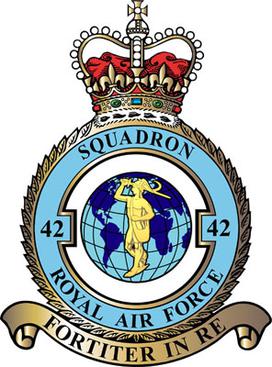
Number 42 Squadron, also known as No. 42 Squadron, is a squadron of the Royal Air Force. It reformed at RAF Lossiemouth on 21 September 2023 as the Operational Conversion Unit for both the Boeing Poseidon MRA1 and Boeing Wedgetail AEW1.

No. 27 Squadron of the Royal Air Force operates the Boeing Chinook from RAF Odiham.
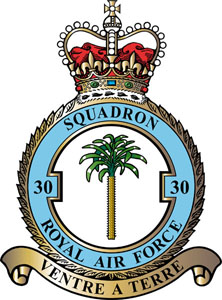
Number 30 Squadron of the Royal Air Force operates the Airbus A400M Atlas transport aircraft and is based at RAF Brize Norton, Oxfordshire.

No. 34 Squadron RAF was a squadron of the Royal Air Force. During the First World War it operated as a reconnaissance and bomber squadron and in the 1930s operated light bombers. It was re-equipped with fighter-bombers in the later half of the Second World War and in the post-war period was reformed four times; first as a photo-reconnaissance unit, then anti-aircraft co-operation, then as a jet fighter squadron through the 1950s. It was last active in the 1960s, as a Blackburn Beverley transport squadron.

No. 452 Squadron is a Royal Australian Air Force (RAAF) air traffic control unit. It was established in 1941 as a fighter squadron, in accordance with Article XV of the Empire Air Training Scheme during World War II. The squadron flew Supermarine Spitfires for the entire war, initially over the United Kingdom and Nazi-occupied Europe. It was later based in Australia and the Netherlands East Indies, before being disbanded in 1945. It was re-raised in its current role in February 2011.
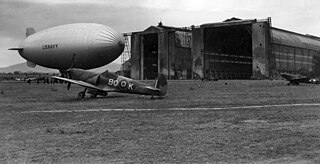
No. 451 Squadron was a Royal Australian Air Force army cooperation and fighter squadron of World War II. It was formed at Bankstown, New South Wales, on 12 February 1941 and began flying operations on 1 July as part of the North African Campaign in Egypt and Libya. No. 451 Squadron was withdrawn for refitting in early January 1942 and spent the remainder of the year performing garrison duties in Syria. In January 1943, it was transferred to Egypt to contribute to local air defence but saw almost no combat. This inactivity caused morale among the squadron's personnel to greatly deteriorate.
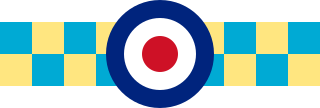
No. 245 Squadron was a squadron of the Royal Air Force. It flew as an anti-submarine squadron during World War I and as a fighter squadron during World War II. After the war it was first a jet-fighter squadron and its last role was as a radar-calibration unit.

No. 455 Squadron was a Royal Australian Air Force (RAAF) torpedo bomber squadron during World War II and became famous as part of the "ANZAC Strike Wing" that was formed from Australian and New Zealand squadrons. Raised in early 1941, mainly from Australian personnel, the squadron served over Europe during the war, operating from various bases in the United Kingdom; it also briefly sent a detachment to the Soviet Union in 1942. Operating Handley Page Hampdens and Bristol Beaufighters, the squadron mainly undertook anti-shipping and anti-submarine operations during the war. It was disbanded in May 1945 following the cessation of hostilities against Germany.

No. 456 Squadron RAAF was a Royal Australian Air Force (RAAF) night fighter squadron, operational over Europe during World War II. Formed in mid-1941, the squadron was the RAAF's only night fighter squadron. It was also the first RAAF unit to use a roundel featuring a red kangaroo in a blue circle, on some parts of its aircraft. While this insignia was unofficial and the squadron's main markings conformed to the RAF roundels used by British and other Commonwealth units, it inspired the post-war roundel used by the RAAF.
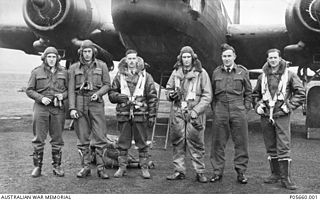
No. 458 Squadron RAAF was a Royal Australian Air Force squadron that operated during World War II. It was formed in Australia under Article XV of the Empire Air Training Scheme. The squadron flew various versions of Vickers Wellington bombers, first in Europe and later in the Middle East. It was disbanded in mid-1945, following the conclusion of hostilities in Europe.

No. 459 Squadron RAAF was a Royal Australian Air Force squadron that operated during World War II. It was formed in early 1942 and served as a maritime patrol and bomber unit in the Mediterranean theatre until early 1945, operating mainly Lockheed Hudson aircraft. In early 1945, the squadron was transferred to the United Kingdom with the intention of being transferred to RAF Coastal Command and converting to Vickers Wellington bombers; however, due to a series of delays the conversion was not completed and the squadron was disbanded in April 1945.
No. 160 Squadron RAF was a Royal Air Force unit during the Second World War, when it flew for four years in a number of roles including heavy bomber, minelaying, reconnaissance, special operations and transport unit in the Middle East and South-East Asian theatre of World War II.

No. 500 Squadron AAF was a Royal Air Force flying squadron. It was initially formed in 1931 as a Special Reserve squadron and in 1936 became part of the Auxiliary Air Force, at this time based at Manston and Detling.
No. 608 Squadron was an Auxiliary Air Force squadron of the Royal Air Force during the Second World War. It flew during its existence as a bomber, fighter and reconnaissance unit and was the only RAF squadron to be equipped with the unsuccessful Blackburn Botha torpedo bomber.

No. 600 Squadron Royal Auxiliary Air Force is a squadron of the RAF Reserves. It was formed in 1925 and operated as a night fighter squadron during the Second World War with great distinction. After the war, 600 Squadron went on to operate jet fighters until 1957. Reactivated in 1999, 600 Squadron is the only RAF Reserve unit within the M25. It is a Headquarters Support Squadron and provides trained part-time reservists to support RAF operations around the world.
No. 82 Squadron RAF was a Royal Air Force squadron that was first formed in 1917 and last disbanded in 1963. It served at times as a bomber unit, a reconnaissance unit and lastly as an Intermediate Range Ballistic Missile (IRBM) unit.
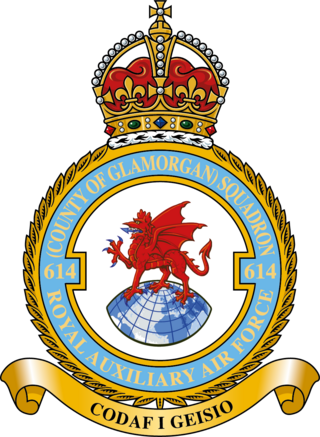
No. 614 Squadron was originally formed on 1 June 1937 as an army co-operation squadron unit of the Auxiliary Air Force. It served during the Second World War first in this role and later as a bomber squadron. Upon reformation it served as a fighter squadron until the disbandment of the Royal Auxiliary Air Force on 10 March 1957.
No. 107 Squadron RAF was a Royal Flying Corps bomber unit formed during the First World War. It was reformed in the Royal Air Force during the Second World War and was operational during the Cold War on Thor Intermediate Range Ballistic Missiles.
No. 114 Squadron was a squadron of the British Royal Air Force. It was first formed in India during the First World War, serving as a light bomber squadron during the Second World War and as a transport squadron post-war. It was last disbanded in 1971.














